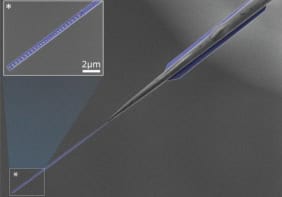
Researchers in the US and Germany have developed a new way to transform DNA into complex shapes by making the molecules twist and bend. The technique could be crucial for making nanoscale device building blocks, such as molecular rings, wheels, solenoids and gears, for applications in areas like drug delivery and optoelectronics.
DNA molecules consist of two linear strands wound into a double helix with one of four different “bases” attached to every sugar group along the strands. Apart from being the “building blocks of life”, DNA is also an attractive engineering material because strands with complementary base sequences recognise and bind to each other, enabling complex molecular structures to be made by self-assembly. Scientists have long known that DNA molecules can bend and twist into complex shapes — for example, DNA in “eukaryotic” cells is packed into nucelosomes in which the molecule bends around proteins with a radius of curvature as small as around 4 nm. The dream has been to create artificial structures that mimic such natural ones.
Manipulating DNA
Now, however, Hendrik Dietz of the Technische Universität München in Germany and Shawn Douglas and William Shih of the Dana-Farber Cancer Institute, Harvard Medical School and the Wyss Institute at Harvard, have taken a big step forward towards this goal. Their technique, which involves either adding DNA base pairs to bundles of DNA helices or taking them away, allows the researchers to construct nano-scale wheels, arches and other continuously curved objects. The direction and degree of bending can be controlled to produce molecules that curve over arcs with a radius as small as 6 nm (Science 325 725).
Shih and co-workers did this by using parallel bundles of DNA double helices, laterally held together by cross-links formed by strands crossing over from one helix to the next to create a rigid starting material. Employing a large bundle of helices is important because it provides rigidity, explains Shih. Indeed, bending would not be as useful if the starting material was too floppy.
Next, the researchers either removed or inserted base pairs of DNA along specific helices, between the cross-links. When a base pair is removed, the double helix contracts, and when a base pair is inserted, the double helix expands.
If base pairs are systematically deleted from one layer while being inserted into the opposite layer of helices, the resulting contraction/expansion makes the structure bend. Put simply, the shape is concave where base pairs have been removed and convex where they have been added.
Curvaceous molecules
Shih’s team says that this is the first time that DNA bending has been controlled in such a way. Previous efforts relied on material interactions with proteins to bend the DNA, whereas the present method relies exclusively on interactions with DNA itself. The structures produced are highly rigid and can be fine tuned over a wide range of curvatures. “Basically we have achieved a big leap in the amount of curvature control, so that’s why our findings are important,” said Shih.
Such rigid, curved DNA structures could be used to construct molecular rings, wheels and solenoids. In turn, these building blocks could be made into devices for applications in areas like plasmonics — for example, to make nanoantennae — and in therapeutics such as drug delivery inside the body.
The team says it would now like to build some simple devices after having demonstrated gears and beachball shapes by joining various curved elements together. The structures also need to be made more robust, which means reducing the amount of defects present in them.



